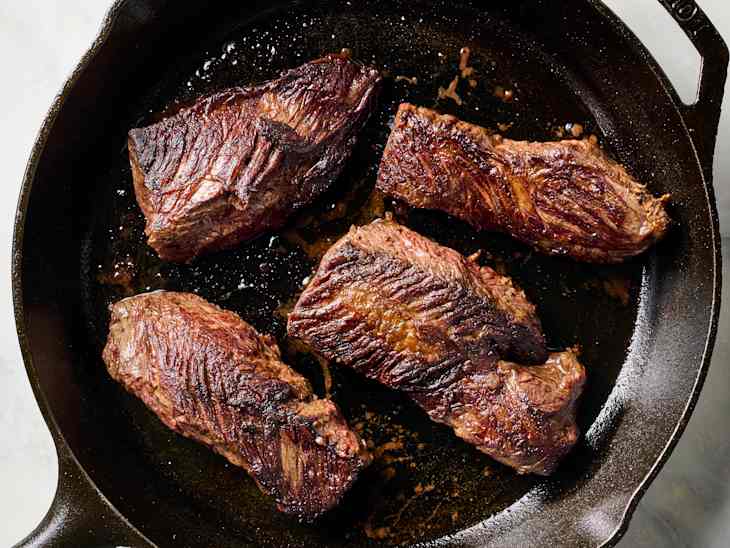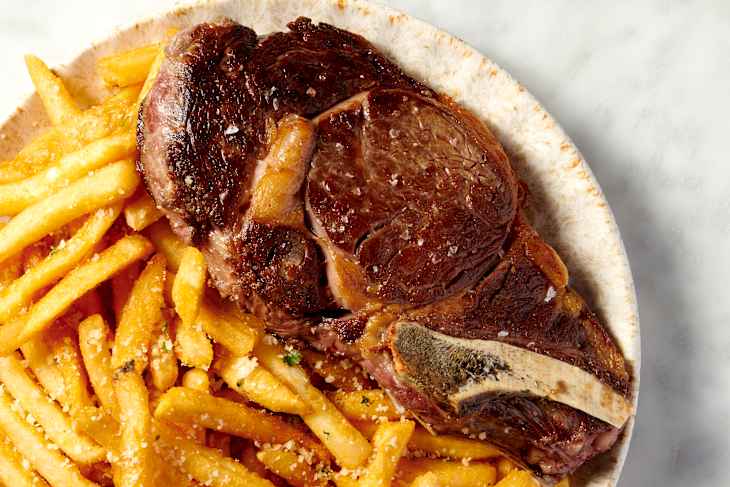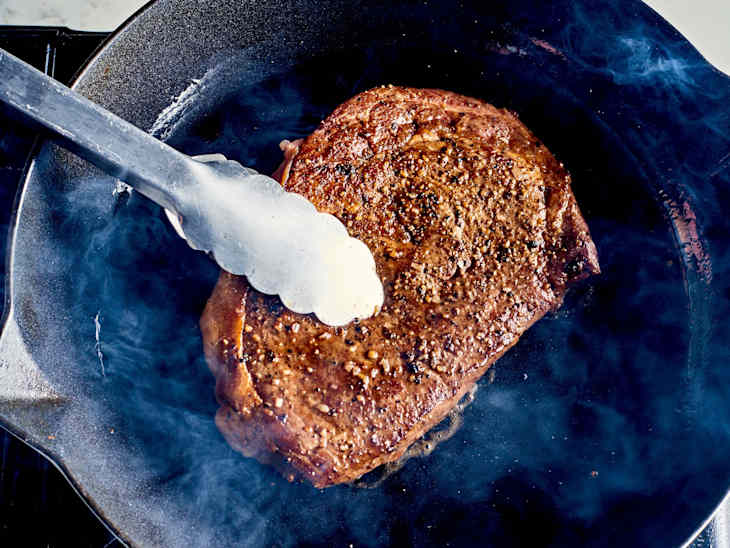

There are many ways to cook a steak, from the oven to the grill and even in an air fryer, but there’s something deeply satisfying about searing a steak on the stovetop — the sizzle when it hits the screaming hot pan, the way the crust forms right before your eyes, and the rich, savory aroma that fills your kitchen.
Whether you’re aiming to impress a date, treat yourself on a Tuesday, or give your wallet a break from overpriced steakhouse dinners, learning how to sear a steak is one of the fastest ways to level up your cooking game. Mastering a steak sear isn’t complicated, but it does require heat, timing, and technique. Once you’ve got it down, you’ll never look at steakhouse prices the same way again.
Here’s how to achieve that ASMR-worthy crust and juicy interior in less than 10 minutes.

Why a Good Sear Matters for Steak
Searing isn’t just about aesthetics; it also makes for a tastier steak. When steak hits a hot pan, it undergoes the Maillard reaction, a chemical process that creates hundreds of complex flavor compounds and a beautiful brown crust. A good sear adds richness, texture, and depth of flavor, locking in juices and transforming a simple cut of meat into something drool-inducing.
What You’ll Need
Equipment:
- Heavy-duty skillet: A cast-iron pan is best for even heat retention and blazing hot temperatures, but stainless steel works, too. Avoid nonstick pans for searing, as the material isn’t safe for use at very high temperatures.
- Tongs: Long, sturdy ones flip the steak without piercing it. Avoid using plastic tongs, as they can melt on a hot pan.
- Instant-read thermometer: Also known as a meat thermometer and probe thermometer, this tool checks for doneness with precision.
- Paper towels: Patting the steak dry first ensures a good sear.
- Spoon: This is helpful for basting.
Ingredients:
- Kosher salt and freshly ground black pepper: For that classic, delicious seasoning.
- High smoke-point oil: Think canola, grapeseed, avocado, or refined peanut oil. Avoid olive oil for this step because it’ll burn before reaching the proper temperature.
- Butter: For basting at the end and adding rich flavor.
- Aromatics (optional): Garlic cloves, thyme, or rosemary elevate your butter baste.

How to Sear a Steak Perfectly
1. Bring steak to room temp. Take the steak out of the fridge about 30 to 60 minutes before cooking. When your steak isn’t fridge-cold, it’ll cook more evenly and achieve a better sear.
2. Dry and season it. Pat the steak dry with paper towels because moisture is the enemy of a good crust. Then generously season all sides with salt. Don’t add the pepper yet because the high heat will just burn it.
3. Preheat the pan. Set your skillet over high heat and let it get hot, really hot. A drop of water should instantly sizzle and evaporate.
4. Add oil. Swirl in a thin layer of high smoke-point oil. Let it shimmer but not smoke excessively. Alternatively, especially if you’re cooking a well-marbled steak, you can coat the steak itself in oil instead of the pan.
5. Sear without moving. Place the steak in the pan and don’t touch it for 2 to 4 minutes. This allows a crust to form. When it naturally releases from the pan, it’s ready to flip.
6. Flip and sear the other side. Cook the other side for an additional 2 to 4 minutes, depending on the thickness and desired doneness.
7. Add butter and aromatics. In the final minute or two, reduce the heat slightly, add a tablespoon of butter and aromatics (including black pepper), and baste the steak by spooning the melted butter over the top.
8. Check the temperature. Use an instant-read thermometer to check the internal temp.
- Rare: 120°F–125°F
- Medium-rare: 130°F–135°F
- Medium: 140°F–145°F
- Medium-well: 150°F–155°F
9. Rest before slicing? You can let the steak rest on a cutting board for a few minutes before slicing against the grain. Some say this helps the juices redistribute, while some say there’s not much difference between a rested steak and one that’s devoured immediately. Personally, if I’m not making a pan sauce, I’m digging in right away, and the biggest difference I notice is that the unrested steak is hotter (and tastier).
- How long do you sear a steak on each side? For a 1- to 1 1/2-inch steak, about 2 to 4 minutes per side over high heat is typical for a medium-rare steak, but always adjust for thickness and your preferred level of doneness. Thicker steaks (1 1/2 to 2 inches) will give you more margin for error when starting out.
- Should I sear in butter or oil? Oil has a higher smoke point than butter, which will burn before your steak even hits the pan. However, butter provides great flavor, so add it toward the end along with aromatics, and baste your steak right before it’s done.
- Do I need to finish the steak in the oven? Not always. For thinner cuts, the stovetop works fine. For thicker steaks over 1 1/2 inches, consider finishing under the broiler for a couple of minutes after searing to ensure even cooking.
- Why pat the steak dry first? Moisture creates steam, which interferes with browning. A dry surface leads to better searing.
- Can I use a nonstick pan? It’s not ideal. Nonstick coatings can degrade at high heat, and they don’t retain heat well. Use cast iron or stainless steel for the best results.
- How do I know when the pan is hot enough? A drop of water should sizzle and vanish instantly. You can also hold your hand a few inches above the skillet — if it feels radiantly hot, you’re ready.